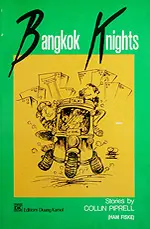 Everybody (publishers and literary agents) say that collections of short stories just don’t sell, but everybody seems to enjoy reading short fiction. I’m an avid reader of short stories and have reviewed on this blog quite a few. Bangkok Knights (or BK!) is one of the very first collections of short stories about Thailand written by a farang writer. It was published in 1989 by Duang Kamol Book House and, ever since, has seen three reprints (1991 – Duan Kamol’s second edition, 1995 – bookSiam, and 2001 – Asia Books). Evidently, the book is out of print, but you can still find an odd copy at various book sales or second hand bookstores.
Everybody (publishers and literary agents) say that collections of short stories just don’t sell, but everybody seems to enjoy reading short fiction. I’m an avid reader of short stories and have reviewed on this blog quite a few. Bangkok Knights (or BK!) is one of the very first collections of short stories about Thailand written by a farang writer. It was published in 1989 by Duang Kamol Book House and, ever since, has seen three reprints (1991 – Duan Kamol’s second edition, 1995 – bookSiam, and 2001 – Asia Books). Evidently, the book is out of print, but you can still find an odd copy at various book sales or second hand bookstores.
Collin Piprell’s other books of fiction include Bangkok Old Hand (stories and essays, 1993), Yawn (a novel, 2003), Kicking Dogs (a novel, 2000), and MOM (a sci-fi novel, seeking a publisher). Bangkok Knights had also been translated into French by Michael Hudon. Collin has also written four non-fiction books about Southeast Asia. Among all these I read Kicking Dogs, a Jack Shackaway novel, which I have to confess I didn’t really like.
Bangkok Knights starts with Salvage Operation, a story that concentrates on Trevor Perry, an Englishman working as traffic engineer in Kuwait, who flies to Thailand in search of a wife. From the airport, instead of the Sheraton Hotel as Trevor requested, the taxi driver takes him to Cher-Tone Guesthouse. Here he meets the narrator, Eddie Alder, the guesthouse owner, his wife (Lek) and his talking parrots, all recurrent characters throughout the book. When they find out that Trevor has scheduled 25 dates in Bangkok and 31 in Manila, they all know he’s in it for a rough ride.
In Leary’s Law, we meet once again Eddie and the narrator, who are at Leary’s house, celebrating the completion of its construction: “Deep in a lane, a soi off Sukhumvit Road, with a big jungley garden and fish ponds, the place was intelligently designed, combining some of the best features of traditional Thai architecture with the option of air-conditioning. We were in the spacious dining nook, looking out through glass doors flanked by cast iron temple lions into an enormous stand of bamboo and yellow-green crotons.” One of the guests at the table is Ernest, who only the previous day broke up with his fiancée. His reason was that her family required him to pay “a bride price.” As Leary “was an expert on women,” he reminded Earnest of his law: in Thailand, marry only an orphan! But, there are other opinions shared and eventually Earnest feels his spirits rise again. After all, even Leary got to break his own law!
 Sid’s Wake is the story of how Sid ‘Siddiqi’ Davis died on his holiday in Bangkok. Constantly worrying about staying healthy and saving money, Sid died at 35 “beneath a woman called Big Toy.” The narrator and his friend, Stack, meet Big Toy in a bar and recall the events that lead to Sid’s tragic end.
Sid’s Wake is the story of how Sid ‘Siddiqi’ Davis died on his holiday in Bangkok. Constantly worrying about staying healthy and saving money, Sid died at 35 “beneath a woman called Big Toy.” The narrator and his friend, Stack, meet Big Toy in a bar and recall the events that lead to Sid’s tragic end.
Billboard is your typical go-go bar story, but with a twist in the tail: this time it’s the ladies who ask the men for favours. Bill ‘Billboard’ Cockburn (pronounced ‘coe-burn’), a fat exhibitionist, enjoys the sleazy sex shows he engages in. But, when two members of the Bangkok Service Girls Protection Association approach him, Billboard might have to change his future acts.
Life-Support System revolves, once again, around the Bangkok go-go bar scene. ‘Dexy’ Devworth, “a beer-bellied, bandy-legged, foul-mouthed whoremaster and offshore oil platform manager” enjoys his regular one month of debauchery, in preparation of the month he’s away at sea. That’s until he falls for #37, an unpredictable Thai bar girl.
Getting Away From It All is about Earnest’s inability to accommodate to the loud noises one hears at every step in Thailand: “People can’t talk to each other anymore; they don’t want to talk. At the same time, they’re uncomfortable with silence. If everything is quiet, then they start to think, and people don’t want to think. They can’t handle it. There are too many horrifying things to think about. So they need insulation. Insulation from each other, in case somebody says something significant, and insulation from their own thoughts, in case they scare themselves to death.” Suffering from “a classic case of noise fatigue,” he goes with his girlfriend to a southern island in the hope of finding peace. Only that even more surprises await for him there!
Lotus Eaters brings the readers back to Eddie’s guesthouse where the stories initially began. Apparently, Eddie was feeling a bit low and pessimistic, until a Nordic diva joined in the conversation. It’s a story that cherries the carefree life lead by back packers and their love of new exotic places. Of course, beer and a “smoke” are never too far away from their discussion.
Although the main character is hangover from a previous mixture of beer and Mekong (Thai whisky), Snapshots is the first (and last!) story in the entire collection that is not about bar girls. It is also the first story that deals directly with the narrator’s (mis)adventures: on a boat trip to the Golden Triangle, where the narrator undergoes research for an article, the boat he was in together with five other foreign travelers, is attacked by three armed Thai men. If, until then, the story read like a Thai version of Three Men in a Boat by Jerome K. Jerome, when the bandits have one of the women undress and a photographer tries to take a picture of their captors, things turn really ugly.
 Crunch is again about Trevor, who continues his search for a Thai wife to take back with him to Kuwait. This time though, Eddie decides to take Trevor to a go-go bar in Bangkok. There, he meets Leary who tries to convince him never to get married, but rather to seize the day…
Crunch is again about Trevor, who continues his search for a Thai wife to take back with him to Kuwait. This time though, Eddie decides to take Trevor to a go-go bar in Bangkok. There, he meets Leary who tries to convince him never to get married, but rather to seize the day…
In Looking for Miss Goodbar, Eddie and the unmanned narrator are given the mission to find a go-go bar girl and deliver her some worrying news.
In Leary’s Exorcism, Leary and his fiancée, Nancy, move into “a lovely house on a quiet soi off Sukhumvit Road” only to later realize that the house was haunted by ghosts. Not even objects of “big magic” like “a masterfully carved wooden mask with glaring ivory eyes and a scowl full of ivory teeth” can help. So, Leary is left with no choice but call a professional exorcist who allegedly can help them get rid of the suspect noises that keep them awake at night.
In Child of Enlightenment, Ernest and his fiancée, Noi, brush with the unexpected and must use the services of Thai hospitals. But the doctor’s advice is never enough, so they make sure the spirit of the Erawan Shrine downtown Bangkok finds out about their problems and helps them overcome them. Collin Piprell makes a very neat reference to Joseph Conrad’s Heart of Darkness in the exclamation “The horror.” Only that Collin refers to the ruin of a man “lost to himself in fatherhood.” For Piprell, the ultimate horror was marriage. For Conrad, it was death.
Mother Makes a Match is a funny story about Frank Keenock, who, even as an adult, fears his mother’s strange ways. The story makes a good point of what are and what aren’t Asian and Western women.
In Too Many Women, Trevor is back from Kuwait to interview more prospective wives, but after more misadventures, he still goes back a bachelor.
In Feeding the Ducks, Bernard Baxter is celebrating his third divorce in a go-go bar in Bangkok.
 Instincts, or Genes, or Something brings the usual suspects in a Bangkok go-go bar where they discuss hangover philosophy.
Instincts, or Genes, or Something brings the usual suspects in a Bangkok go-go bar where they discuss hangover philosophy.
A Day at the Beach is the best and last short story of the collection, both structure wise and plot wise. It is the story the readers were expecting ever since they had opened Bangkok Knights: a story about the narrator, told by the narrator himself. Together with his girlfriend, Sunantha, the narrator, a 36 years old freelance writer, goes to Pattaya for a day at the beach. The narrative is constantly interrupted by the narrator’s thoughts and the reader soon realizes that the main character is going through a rough time in his relationship with Sunantha. The story’s end is both hilarious and beautiful, bringing the entire collection to a satisfied closure.
What I find worth noting about Collin Piprell’s collection of stories is that, although all the stories are stand alone narratives, they intersect with one another, creating a neat connection between both the characters and the many plots.
Visit Collin’s blog about generating realities, exploring them, and losing the thread here.
